The Cabinet of Dr. Caligari: Dark Relationship With Postwar Germany
In the wake of World War I, a pall of gloom was cast over Germany. Robert Wiene’s 1920 film The Cabinet of Dr. Caligari utilized a distinctive mise en scene and a series of narrative implications to capture a sense of dread that was unique to the Weimar Republic. The unique context of post-war Germany contributes to this, since memories of the war impacted broad societal attitudes and the creative forces of artists. These viewpoints framed the various, arguably conflicting messages in the narrative, which conveys fear and continuity in a way that tapped into the attitude of a nation trying to recover from what was then the most costly war in its history.
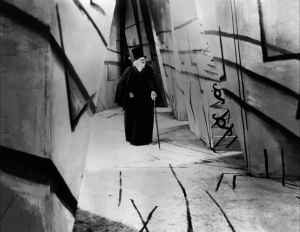
Context of Caligari
The nation of Germany was devastated after its defeat in World War I. Its imperial government replaced by a democratic system known as the Weimar Republic, Germany faced strict economic sanctions from the victorious Allied nations and massive resource shortages. 700,000 Germans died of hunger in the postwar period. For the citizens still alive, though, the war continued to take a toll. While the nation’s exterior shined of industrialized modernity, the “double wound of war and defeat festered beneath the glittering surface.” The morale and spirits of German civilians were shattered to the point where many were looking for a sense of escape from the realities around them. This effect was even more sharply felt by veterans of the war, though. Hans Janowitz, one of the writers of The Cabinet of Dr. Caligari, was an officer during the conflict, and became a pacifist afterward after witnessing the horrors of war. Janowitz and fellow pacifist Carl Mayer were both so affected by the war that they wrote The Cabinet of Dr. Caligari as a response to the unchecked governmental authority that the war was both born of and nourished by. All told, the effects of World War I profoundly impacted the lives of German citizens, causing many of them to dejectedly turn inward.
The postwar period was also the breeding ground for many artistic endeavors, however. Many of these developments are vital in deconstructing The Cabinet of Dr. Caligari and its relationship to the context in which it is made. A key movement that arose in Germany during this period was Expressionism. Emphasizing distorted landscapes and subjects, the movement intended to give expression to things which were beyond words. Expressionists sought to “emphasize subjects suggestive of interior states,” and to reflect on inward identity. The expressionist movement is thus related to postwar Germany because it reflects Kracauer’s assertion that civilians were eager to “withdraw from a harsh outer world into the intangible realm of the soul.” Expressionism manifested itself in film through the use of distorted sets and exaggerated performances, aiming to create a subjective experience – a goal that was in line with the movement as a whole.
Expressionism was just one major artistic advance that led to the uniqueness of The Cabinet of Dr. Caligari. Closely related to the movement’s prominence in film during the early postwar period was the expansion of the German filmmaking industry. Due to high inflation rates, German companies were able to make movies and expand their business with much lower costs than in other countries. The fiscal ease with which studios could make lavish, elaborately-designed films coincided with the building of more movie theaters, creating a larger market for an audience that wanted to spend their money before inflation rendered it useless. This ability to construct sets that could faithfully capture the spirit of expressionism was crucial to the movement’s transition to film. Indeed, when the economy began to recover and more constraints were applied to film production, markedly fewer Expressionist films were made.
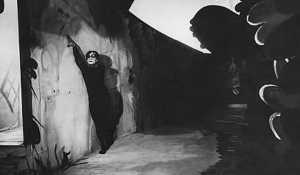
Visual Storytelling and Caligari
The Cabinet of Dr. Caligari was the first German Expressionist film, and it still characterizes the movement’s cinematic endeavors most notably. The film’s use of Expressionist style uses the movement’s uniquely postwar sensibilities to create an atmosphere of tension and dread that characterized German sentiments towards authority at the time. At [40:03-44:17], the sequence in which the somnambulist Cesare attempts to kidnap Jane, there are very clear Expressionist visual cues that invoke terror. Take Jane’s room; the patterns on the walls create a sharp point that echo Cesare’s entry into the room and his unsheathing of a dagger. Another noteworthy example is at the very end of the sequence, where the jagged, sharp trees mirror the contorted movements of Cesare’s death. Such aesthetic representations of tension served to externalize moods or emotions that would normally be construed as inward phenomena. The Expressionist style brought these internalized feelings and made them an integral part of The Cabinet of Dr. Caligari’s mise en scene. In essence, the Expressionist design of the film allowed audiences to look inward by using a sense of visual language that turned the world of the film inside out.
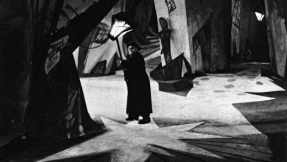
Kracauer argues that this Expressionist perspective contributed to the postwar mindset of a “retreat into a shell” on the part of the audience. However, the Expressionist direction that the film took can also be read as a confrontation on the inward anxieties held by those affected by the war. One way in which expressionism arguably did this was through the very nature of its design: distorted and barren. These qualities forced the audience to reckon with a new form of reality that challenged prior interpretations of the world, including interpretations that championed authority and dominance. Also, the claustrophobic and cluttered design of the fictional town of Holstenwall as seen in shots like [21:03] could be seen as an attempt to evoke wartime trench warfare imagery, a direct confrontation with veterans. While Kracauer accurately deduced that The Cabinet of Dr. Caligari’s Expressionist art direction emphasized the subjective and the inward, he was wrong in that this introspective viewpoint encouraged escape. The film didn’t offer escape; it bombarded the audience with a mise en scene that implicitly and explicitly bombarded viewers with an affront to complacency and grim reminders of the war.
The Expressionist art style wasn’t the only visual method used to engage with postwar attitudes. The circular motif running throughout The Cabinet of Dr. Caligari reinforces fears faced by German citizens at the time of the film’s release. Visually, circular visual cues can be seen most prominently at Holstenwall’s fair, such as shots like [9:46]. One of the few scenes of organic human movement, the fair also serves as the point where Caligari first awakens Cesare for public viewing. Given that circular visual cues are dominant in these scenes of both untamed human activity giving way to impending doom, the circle can be taken as a symbol of drastic change. Supporting this interpretation of the circular as a sign of change are scenes that take place in the insane asylum run by Caligari. The main room of the building, clearly seen in shots at[49:55] and [1:04:41], is noticeably circular, with the distorted lines on the floor drawing the viewer’s eye towards the shape. Two important scenes take place at the asylum, a setting defined by its central, circular point. The first is that Caligari is imprisoned in his own asylum, overthrown from his murderous dominion. The second is the twist ending that the protagonist Francis was the insane one, with Caligari being a seemingly-friendly doctor. Francis is straitjacketed in this scene, his freedom constricted. In light of these scenes, the circular motif in The Cabinet of Dr. Caligari can be read not merely as a sign of change, but of revolution (Roberts, 184). Cyclically, Caligari has gained authoritarian power, been stripped of it, and then given it again in a twist of fate – all of which was forecasted by the circular motif. By emphasizing the circular visual elements of the film, Wiene established a visual motif that hinted at the specter of unrest and the never-ending cycle of authoritarianism, a fear in the minds of German citizens.
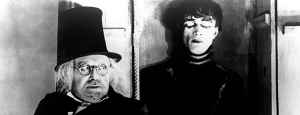
Authority and Caligari
The mise en scene of The Cabinet of Dr. Caligari is only one side of the dread-ridden atmosphere cultivated by The Cabinet of Dr. Caligari. The narrative efforts and implications of the film are heavily shaped by the postwar German attitudes. Before addressing the final cut of the film, though, the shadow of the script by Mayer and Janowitz must be addressed. For a long time in film history, the widespread belief was that the original draft of the script did not include the framing device of Francis’ insanity. This is significant because, sans the twist unwelcomely ending added by Wiene, the film ends on a note that champions overthrowing authoritarian figures. Crucially, this ending would have criticized the state power of using its authority to conscript soldiers to wage war, as Caligari did through his hypnotizing of Cesare. Such a politically-critical stance was blunted, critics argued, by the reduction of the anti-authoritarian Francis to a mad man, thus implying that countering authority was delusional and “conformist.” Wiene was demonized for this supposed neutering of The Cabinet of Dr. Caligari’s message, but discovery of an original screenplay of the film has led to pushback against this stance. For one, the original script by Mayer and Janowitz always included a frame story. While the original draft was still decidedly counter authoritarian, accusations that Wiene attempted to dull the message are unfounded.
The reason why Wiene shouldn’t be accused of neutering the film’s message is because the addition of the framing device creates a resonant message of cynicism. In the framing device, Caligari is returned to his position of power after having been stripped of authority. Indeed, Caligari’s loss of power was illusory all along, a reflection of the cyclical motif that played a large visual role in the film. Arguably, this drastic shift and then return to the status quo was a reflection of events that Wiene witnessed in his own life. In 1918, the Kaiser and his regime were overthrown, but these elements were, not long afterward, restored to power, so the idea of revolution was as false as Francis’ story. Taken with this historical context, Wiene’s framing device was not a cowardly attempt to rob the film of political meaning, but instead a rebuttal to the counter authoritarian stance with the grim reminder that authority will always reassert itself. Even Kracauer, a critic of Wiene’s, acknowledges that the basic theme of The Cabinet of Dr. Caligari is that the soul is faced with either chaos or tyranny. This pessimistic outlook on the prospect of a revolution overcoming authority is due to Wiene’s addition.
Wiene’s contribution imbued The Cabinet of Dr. Caligari with a sense of historical context that asserted the inevitability of authoritarian rule. However, Mayer and Janowitz’ original plot remains powerful within the scope of the framing story due to the way it portrays the process in which authoritarian figures come to power. Caligari’s control of Cesare and its similarity to the way governments control its citizenry and army has already been mentioned, but Caligari asserts his control in other, less obvious ways. At [11:05], an intertitle begins the sequence where Caligari attracts fairgoers into seeing his exhibit, garnering their attention and thus ensnaring them in his control. Similarly, the film as narrated by Francis establishes Caligari as a figure of high esteem, the director of the asylum. That Caligari came from a respected upper class reflected tensions in postwar Germany that a “monumental struggle between left and right was taking place.” By establishing Caligari as both a tyrant and a seemingly mild-mannered member of society, Mayer and Janowitz’ original story addressed both the origins of authoritarian power and the anxieties Germans had about a potential revolution in the making. Ultimately, the narrative implications of the story, with or without the framing story, showed a distinctly postwar fear about how a privileged class could rise up and take authority over the state.
One last narrative implication that creates a mood unique to postwar Germany is that Caligari’s very ability to travel and kill indiscriminately is a symbol of the nation’s state of disarray. While Kracauer and Roberts have argued opposing viewpoints about the role of authority and revolution in The Cabinet of Dr. Caligari, neither has addressed that, at the time the film was released, Germany was in the throes of chaos. While Germans were surely anxious of the inevitability of authority, and the film expertly encapsulates these fears, the horrific content of the film’s story represents a country in the midst of turmoil at its most basic level. The main plotline, a murderer wreaking havoc in a quaint village totally unmolested by anyone, is a metaphor for Germany’s postwar state. In deeper layers of the narrative, the fundamental problems that have plagued and would continue to plague Germany are explored, but the literal plot in itself represents the problems plaguing Germany at that very moment in time.
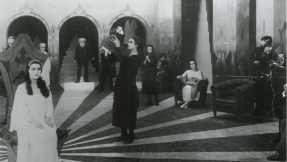
So in sync was The Cabinet of Dr. Caligari to the mood of postwar Germany that it managed to predict Germany’s next great crisis: the rise of Hitler. The authoritarian rise of Caligari and the indiscriminate killing he perpetrates through a hypnotically obedient party foreshadows the rise of just such a figure in real life. Hitler’s rhetoric and use of propaganda echoes Caligari’s ability to draw a crowd and his control of Cesare. While clearly neither Wiene nor Janowitz nor Mayer could have foreseen the rise of Hitler, but the rise of fascism and Germany was just as inexorably linked to postwar conditions in Germany as The Cabinet of Dr. Caligari was. The film’s perceptive grasp of the issues at hand made it able to craft a visual and narrative language that, unfortunately, predicted what would happen if the cycle of authoritarian continuity was left unbroken.
Conclusions
The Cabinet of Dr. Caligari’s unique visual style made use of the Expressionist style and an unrelated circular motif in order to stress the inward fears and anxieties felt by many Germans while at the same time forcing them to confront the continual cycle of authoritarian power. The narrative qualities of the film reasserted the inevitable nature of authoritarian power, the ways in which such a power rises, and the horrific environment that such an authority could rise in. Together, these traits combined to produce a film that exuded a sense of dread that was unique to postwar Germany. The anger, fear, and loss felt by Germans during this period were hidden by modernity and introspection, but the Expressionist, cynical nature of Wiene’s film forced Germans to come out of their self-imposed inward gaze and look at the exposed, distorted reality that Germany’s problems were far from over.
Works Cited
Hobbs, Robery Carl. ““Early Abstract Expressionism: A Concern with the Unknown Within.” Abstract Expressionism, the Formative Years. By Robert Carleton Hobbs and Gail Levin. Ithaca, NY: Herbert F. Johnson Museum of Art, Cornell U, 1978. N. pag. Print.
Kaes, Anton. Shell Shock Cinema: Weimar Culture and the Wounds of War. Princeton: Princeton UP, 2009. Print.
Kracauer, Siegfried. From Caligari to Hitler: A Psychological History of the German Film. Princeton, NJ: Princeton UP, 1974. Print.
LoBrutto, Vincent. Becoming Film Literate: The Art and Craft of Motion Pictures. Westport, CT: Praeger, 2005. Print.
Roberts, Ian. “Caligari Revisited: Circles, Cycles and Counter-Revolution in Robert Wiene’s Das Cabinet Des Dr. Caligari.” German Life and Letters 57.2 (2004): 175-87. Web.
Thompson, Kristin, and David Bordwell. Film History: An Introduction. New York, NY: McGraw-Hill Higher Education, 2010. Print.
What do you think? Leave a comment.











This film still is creepy, with its black and white look, and the nightmare like atmosphere. A great analysis for one of the 1st great horror films.
I always liked German Expressionism’s aesthetic style, particularly in later films such as Metropolis and M.
This is a gothic masterpiece. I wouldn’t be surprised if someone told me that Edgar Allan Poe wrote the script for this movie (I know he didn’t, he was dead by then)
i read somewhere that this is the first movie ever with twist ending
Boy do I love that mise-en-scene. These weimar cinema sets were amazing. I don’t care much for the narration, but that was just plain brilliant.
just watched this movie in my history of cinema class, absolutely amazing
I love this article and this film. In my final year I took an art and film module and for one of my essays I wrote about this film in connection to Nietzsche’s concept of will-to-power, I enjoyed writing it so much.
This is my favorite movie
It’s crazy to think that this production cost probably hundreds of thousands of dollars to make during its time…and now it’s public domain and we watch it for free.
First silent film i’ve ever seen. Brilliant! brilliant! Brilliant!
Brilliant Film…. I have to research the expressionist art movement as part of an assignment. This film puts it all into Context :-)… Dr Caligari is entertaining… Really Scary and shady Character….
This was an excellent deconstruction of how German filmmakers at the time understood and represented the state of their country in their films. It made me think of Metropolis and how ahead of its time it was in terms of critiquing class structure and big industry/government. I haven’t studied Caligari as closely, so thank you!
Filming in black and white is , in my opinion, far superior to color. It’s visually more exciting. Though, it’s not just a matter of film choice, it has to do with the use of shape, space (positive and negative), shadow, and tone. Too bad more films aren’t made this way. I wish color, and sound, had stayed out of motion pictures for an extra 10 or 20 years.
If they were going to remake this; I’d cast Anthony Hopkins as the Doctor.
Kevin,
This was an excellent piece; thorough in its research and filled with convincing assertions, your article has helped me better understand this mysterious film. The first time I saw it, I got hints of the themes of authoritarianism that the filmmakers were playing around with, and I was also aware that the film more or less gave birth to the German Expressionistic movement. I did not, however, figure that both were linked, and moreover, that the scenery was meant to be metaphorical. Truth be told, I figured the warped scenery was just an attempt by the director to be original; after reading your piece, I am now aware that and convinced by the idea that Wiene was actively trying to create an environment which showed how the decay of the German people’s inner being was corrosive to their society. What a magnificent way to interpret the film. Again, this was a great piece and has helped me appreciate the idea of visual metaphors even more.
-August
This was the first film I watched in my first ever film class in college – and despite some of the ways a more modern audience could be put off by it, the creepiness is still on point.
First time I am able to say that I’m not ashamed of my german being
You should never be ashamed anyway… Hitler hypnotized the German public and used the economic climate as a means to do so. If the economic climate, the allies economic sanctions and inflation through the roof – world war two would never have come to pass.
I just can’t watch it, overrated sick film ? or is it me ?
Great film, and a good analysis.
You’re absolutely right to say that this film signaled the “retreat into the shell” type of films that expressionism strived for, but not just for films but for the nation as a whole.
I always depicted the ending as saying that it was the rest of the world that was mad, and that despite what we may observe, to never fully trust the facade presented us, but to instead seek our own truth. Again, focusing more on introspection than observation.
I think the bad quality makes it even better.
A good essay. I remember this movie discussed in a graduate course on Modern Germany I took. If I remember correctly, the movie is discussed in a book by Peter Gay on Weimar Culture, one of the books I read for this course. Again, a good essay. Nice to read something that recalls a memory from a course I enjoyed.